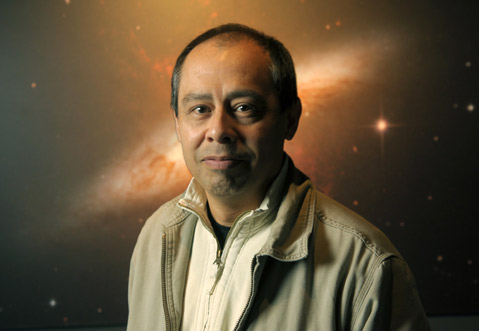My Life: The Magic of Astronomy
Museum of Natural History Curator Reflects on a Career in the Stars

“Pick a card, any card!”
People get excited and uneasy when they hear a magician speak these words, and feelings of amazement and disbelief ensue once the trick is completed. But for some of us, a deeper sense of wonder occurs when we discover on our own how the illusion is done, how this modern wizard uses physics, psychology, chemistry, and even mathematics to create a feat of so-called magic.
To me, the universe is like a magic trick. Its size, complexity, and hidden secrets can make us uneasy, so much so that we try to explain them as acts of some deity. But centuries of tireless efforts by scientists have provided us with a better understanding of how our universe works, and I find this quest for knowledge as impressive as the universe itself. To this day, I enjoy a great sense of fascination every time a new discovery is made.
Born and raised in Mexico City, I studied physics and math because I wanted to learn more about the world around us. My interest for astronomy started upon seeing a total solar eclipse in Mexico in 1970, but it became my passion after seeing the Hubble Deep Field image of 1995. It’s very difficult not to be deeply impressed by that discovery, which revealed that our universe is billions of years old and filled with billions and billions of galaxies!
After 15 years of teaching, my wife and I decided to leave our good life in Mexico and move to Santa Barbara, where I went back to school to become an x-ray technologist. Serendipitously, I found a part-time job in astronomy at the Santa Barbara Museum of Natural History, where I was promoted to manager a few years later. Currently, I juggle my museum job with taking x-rays, teaching astronomy for SBCC, and tutoring math.
A big part of my job is studying these new discoveries in order to go onstage to amaze others. At the Gladwin Planetarium, I lead virtual tours of planets, nebulae, galaxies, and even black holes, and through our telescope, I show off, among other things, unbelievable views of Saturn and the Owl cluster. And with the renovated Palmer Observatory’s new big telescope, those views are going to be even more spectacular. It’s a lot of work, but I am paid for my passion, and, at the end of the day, I get to be that illusionist: Javiero El Magnífico!
I’m still waiting for that greatest of all discoveries: life on another planet. It will happen sooner rather than later. And when it does, I hope I am still around to be amazed … again.
4•1•1
The S.B. Museum of Natural History will reopen the long-dormant Palmer Observatory on October 5. The public’s next best chances to observe the heavens at the museum are the lunar eclipse on September 27, the Draconids meteor shower on October 8, and star parties on October 10, November 14, and December 12. Those with deeper interest can attend the Astronomical Unit meetings in Farrand Hall on October 2, November 6, and December 4.



